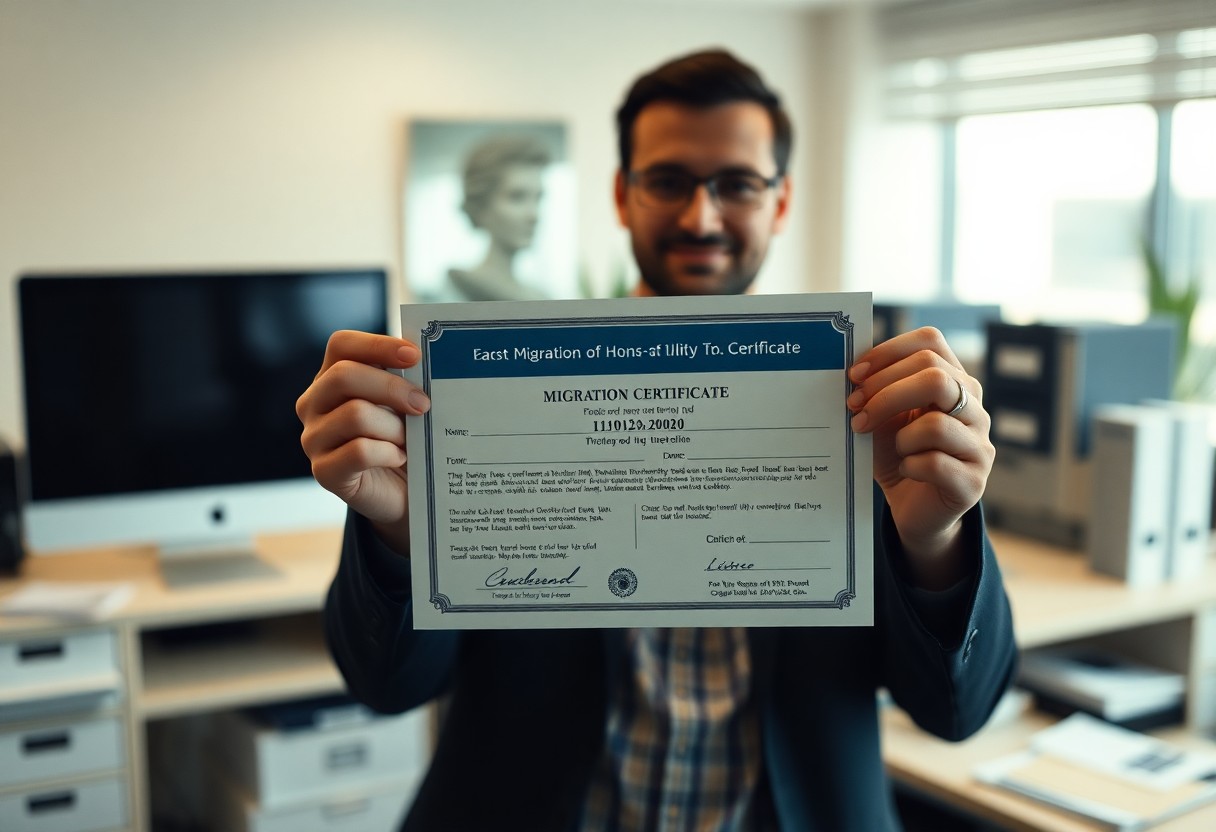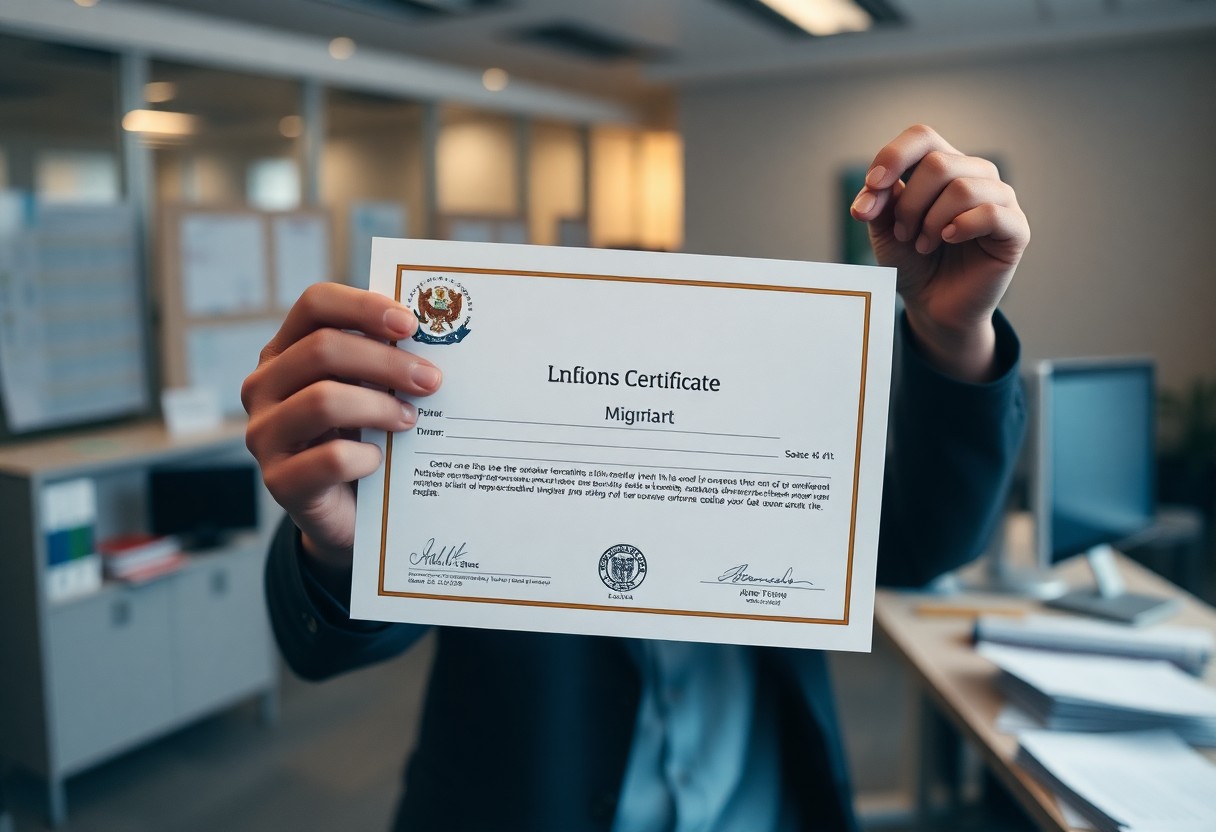Obtain a migration certificate to seamlessly transition between educational institutions or to pursue further studies abroad. This important document verifies your previous academic records and ensures you don’t face unwanted delays during the admission process. In this guide, you’ll learn the crucial steps you need to follow to secure your migration certificate efficiently, avoiding common pitfalls and ensuring all necessary paperwork are in order. Let’s examine the process so you can obtain your migration certificate with ease.
Table of Contents
Key Takeaways:
- Application Process: Begin by filling out the migration certificate application form provided by the respective educational institution.
- Required Documents: Gather and submit necessary documents such as your mark sheets, ID proof, and any institution-specific requirements.
- Fees Payment: Pay the applicable fee for processing the migration certificate, ensuring you keep the receipt for future reference.
Understanding Migration Certificates
Before you navigate the process of obtaining a migration certificate, it’s important to grasp its significance and relevance in your educational journey. This document serves as proof of your academic history and is vital when transferring from one institution to another. Understanding its components and the required steps can help smooth your transition and ensure you have all necessary documentation in place.
What is a Migration Certificate?
Now, a migration certificate is an official document issued by an educational institution that certifies a student’s enrollment status and details related to their academic performance. It indicates that you have completed a specific course or program and are eligible for further studies. This certificate is crucial when you seek admission to a different college or university.
Importance of a Migration Certificate
While pursuing further education, a migration certificate holds immense value as it validates your previous academic credentials to prospective institutions. It prevents unnecessary delays in your admission process and ensures a seamless transition to your new educational environment.
What many do not realize is that without a migration certificate, you may face significant obstacles in gaining admission to a new school, as universities often require this document for registration. It aids in preventing complications related to duplicate records or eligibility issues. Obtaining a migration certificate not only streamlines your process but also establishes your academic legitimacy, providing a clear path for your future studies.
How to Apply for a Migration Certificate
One of the first steps to obtaining your migration certificate is to check the application procedure outlined by your specific educational institution. Institutions often have different requirements and processes, so ensure you follow the directions provided by your school or university. You may need to fill out a specific form, pay application fees, and submit the required documents to initiate the process of receiving your migration certificate.
Gather Required Documents
One of the key components of your application is to gather all necessary documents. Typically, you will need your previous institution’s bonafide certificate, mark sheets, identification proof, and possibly an application form. Ensure you have photocopies and original documents ready to submit.
Submission Process
Certificate submission typically involves handing over your completed application form along with the required documents to the appropriate department, such as the registrar’s office. You may also have the option to submit your application online depending on your institution’s facilities. After submission, keep track of the application status and ensure you receive the appropriate acknowledgment.
Required documentation for submission must be complete and accurate, as any discrepancies can lead to delays or even rejection of your application. Be sure to include all necessary supporting documents and make any required payments. Stay informed about the timelines within which you can expect to receive your migration certificate after submission, allowing sufficient time for processing to avoid any disruption in your future educational plans.

Tips for a Successful Application
All applicants should take these steps to enhance their chances of a successful migration certificate application:
- Ensure all required documents are ready.
- Fill out the application form completely and accurately.
- Double-check for any fee payment requirements.
- Submit your application well before any deadlines.
Knowing these tips helps streamline the process and minimizes delays.
Verify Eligibility Criteria
With every application, you must first verify your eligibility for a migration certificate. Check the specific criteria set by your institution or authority, which may include completing your program and settling any pending dues. Familiarizing yourself with these requirements will aid in avoiding unnecessary complications.
Follow Up on Application Status
Status updates are imperative after submitting your application. Stay proactive by checking in regularly with the concerned authorities to understand where your application stands. This demonstrates your commitment to obtaining your migration certificate.
Another effective strategy is reaching out via emails or phone calls to inquire about your application status. Ensure you have your application reference number handy for quicker assistance. Delays can occur, be it due to administrative backlogs or missing documents, and timely follow-ups can help address these issues before they become more problematic. You’ll find that being proactive in your approach often leads to a smoother experience overall.
Common Factors Affecting Approval
Your application for a migration certificate can be influenced by several factors. These include:
- Institutional Policies
- Accuracy of Submitted Information
- Documentation Completeness
This knowledge can help you to navigate the application process more smoothly.
Institutional Policies
Any institution may have specific rules and procedures that dictate how migration certificates are issued. Understanding these policies is vital as they can differ significantly between educational bodies and regions. You should consult your institution’s guidelines to ensure that your application aligns with their requirements.
Accuracy of Submitted Information
With any application, the accuracy of the information you submit is vital for a successful approval. Inaccurate or misleading data can lead to delays or even outright rejection of your request for a migration certificate.
Understanding the importance of accuracy in the details you provide cannot be overstated. Any discrepancies, including misspelled names, incorrect dates, or mismatched documents, may raise red flags during the review process. Moreover, providing incomplete documents can result in a negative assessment, prolonging the certification process. It’s vital to double-check your application materials to ensure every piece of information is correct and consistent with official records to achieve a positive outcome.

Troubleshooting Common Issues
Many applicants face challenges when obtaining their migration certificate. It’s important to identify common issues that may arise during this process, such as incomplete documentation, eligibility questions, or discrepancies in your records. By understanding these potential pitfalls, you can take proactive measures to resolve them swiftly and efficiently.
Delays in Processing
Even with thorough preparation, you may experience delays in processing your application. These delays can be caused by high volumes of requests or administrative inefficiencies. It’s advisable to stay in contact with the issuing authority for updates, ensuring your application is progressing as planned.
Reapplying for a Certificate
Little errors in your initial application may necessitate reapplying for the migration certificate. If any details were incorrect or documents were missing, it’s crucial to rectify these issues before submitting a new application.
Plus, when reapplying for a certificate, you should take extra care to double-check all the required documentation and ensure each form is filled out accurately. Be attentive to any specific guidelines that the issuing authority outlines. This not only helps expedite the process but also minimizes the chances of facing further complications. Failing to correct previous mistakes could lead to repeated delays or even rejection of your new application, emphasizing the need for meticulousness.
Additional Resources
Once again, obtaining a migration certificate can be streamlined with the right resources. Various online platforms and institutional contacts can provide you with updated information and guidance tailored to your specific needs. Explore official educational websites, forums, and government portals that offer comprehensive support for your certificate application journey.
Contact Information for Educational Institutions
Assuming you need specific information about the migration certificate process, reaching out to your educational institution directly can be immensely helpful. Most institutions have designated departments or personnel available to address your queries, ensuring you receive accurate and prompt assistance tailored to your situation.
Online Platforms for Application Tracking
Assuming you want to stay informed about your application status, many educational institutions provide online platforms where you can track the progress of your migration certificate request. These platforms are designed to keep you updated in real-time, allowing you to avoid delays and plan accordingly.
Application tracking systems generally offer a user-friendly interface where you can enter your application details to access current status updates. This feature is particularly beneficial as it allows you to easily check if your request is under review, approved, or requires any additional documentation. Leveraging these tools can save you time and help ensure your application proceeds smoothly.
Summing up
Ultimately, obtaining your migration certificate involves a clear understanding of the steps you need to take, from collecting the necessary documents to submitting your application to the concerned educational institution. Ensure that you follow the specified guidelines to avoid delays, and if you need additional insights, you might find it helpful to explore What Is Migration Certificate For Higher Studies 2024. By staying informed, you can streamline the process and focus on your academic aspirations.
FAQ
Q: What documents are required to apply for a migration certificate?
A: To apply for a migration certificate, you generally need to submit the following documents:
1. A duly filled application form provided by the institution or university.
2. A copy of your previous educational certificate (mark sheets or degree).
3. Any identity proof such as an Aadhaar card, passport, or student ID.
4. Payment receipt for the application fee, if applicable.
5. A No Objection Certificate (NOC) from the respective institution may also be required in some cases.
Make sure to check with your specific institution for any additional requirements.
Q: How long does it take to receive the migration certificate?
A: The processing time for a migration certificate can vary depending on the institution or university’s policies. Typically, it may take anywhere from a few days to a few weeks to issue the certificate after a complete application is submitted. Some institutions offer expedited services for an additional fee, while others may have a standard processing time. It’s advisable to inquire with the admissions or registrar’s office for specific timelines regarding your application.
Q: Can a migration certificate be issued if there are outstanding fees?
A: Most institutions have a policy stating that all pending fees must be cleared before issuing a migration certificate. If you have outstanding dues, it is recommended to settle them first to avoid any delays in obtaining the certificate. In some cases, you may be able to request a provisional migration certificate while you work towards clearing the outstanding fees, but this varies by institution. Always check with the university or college for their specific guidelines regarding fees and the issuance of migration certificates.